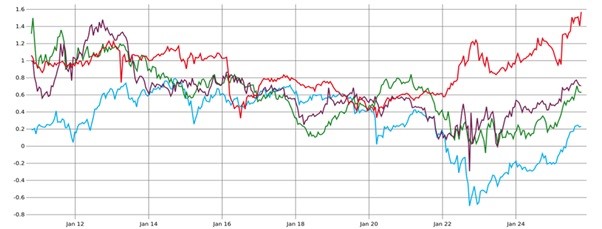
Insurance outlook: Managing change is business as usual
KEY POINTS
We live in a fast-changing world, where organisations need to adapt in order to thrive – and this is especially true for insurance companies. Insurers are impacted by economic cycles and fundamentals, but unlike many other sectors, they must also navigate financial market risks and ongoing developments in regulatory frameworks. In the current fluid environment, agility and risk management are key.
Looking back over the past five years from the pandemic to the present day, it has been a bumpy road for insurers. After a decade of ultra-low interest rates, post-pandemic-driven supply-side disruption, followed by the Russia-Ukraine conflict, led to an unprecedent spike in inflation, monetary policy tightening and a surge in interest rates and interest rate volatility.
However, the typical adverse consequences of more restrictive financing conditions did not materialise, with the US particularly showing surprising resilience. The influence of much tighter monetary policy has been offset by stronger-than-anticipated consumption and investment as well as a significant fiscal expansion.
This period offered a mix of challenges and opportunities for insurers. Interest rate volatility is complex to manage but all-in-all, yields at multi-year highs and resilient risk assets have allowed insurers to rebuild book yields – that is, bond yields locked in at purchase time - and to strengthen their balance sheet.
Easing back
Inflation and monetary conditions have been progressively easing, although at different paces, across different economies. Gloomier macroeconomic conditions in Europe and a faster convergence toward its target inflation rate pushed the European Central Bank to start normalising policy rates as early as mid-2024, reaching 2% in mid-2025. The Organisation for Economic Co-operation and Development (OECD) expects Euro Area GDP growth of 1.2% in 2025 and 1.0% in 2026.1
However, the situation in the US is very different, with the Fed Funds Rate at 3.75%. Market expectations are for US rates to fall to 3.0% in 2026, reflecting both the expected softening of the labour market and GDP growth, and above-target inflation. Notably, market expectations are still subject to uncertainty over the economic impact of President Donald Trump’s trade tariffs and overall policy, while the OECD is forecasting US GDP growth to fall from 2.8% in 2024 to 1.8% in 2025 and 1.5% in 2026.1
A global easing cycle, with downward rate adjustments along the curve, can pose a challenge for insurers. Such an environment calls for sound management of duration and reinvestment risks, especially for those insurers whose liabilities are not properly matched - but this time it seems to be different.
- {https://www.oecd.org/en/publications/2025/09/oecd-economic-outlook-interim-report-september-2025_ae3d418b.html;OECD Economic Outlook, Interim Report September 2025}
- {https://www.oecd.org/en/publications/2025/09/oecd-economic-outlook-interim-report-september-2025_ae3d418b.html;OECD Economic Outlook, Interim Report September 2025}
Curve steepening and compressed credit and equity risk premia
Despite a softer growth and inflation outlook, interest rate curves have steepened in most major markets, reflecting political uncertainty and the resurgence of concerns around fiscal expansion, fiscal deficits and debt sustainability. The US and French situations are symptomatic, as illustrated by recent credit rating downgrades.
Curve steepening across major markets

Key: Blue line: euro swaps; green line: US Treasuries; purple line: UK gilts; red line: Japanese government bonds. Source: Barclays Live
Ongoing political instability combined with expected increases in net issuance next year might reinforce a shift in sovereign risk premia. Other technical factors could also exacerbate curve steepening, such as the Dutch pension system reform, which is expected to drive a significant reduction in long duration positions held by pension funds, potentially leading to further increases in long-term rates and volatility.
On paper, steeper interest rate curves are beneficial for insurers, especially those running long-term liabilities as they can capture higher yields and generate higher investment earnings. But it is not always that straightforward.
Moving into long-duration bonds too quickly can leave insurers with significant unrealised losses and reduce their ability to manage and rotate portfolios. Insurers who are long receiver swaps – that is, receiving a fixed interest rate and paying a floating interest rate – could see their liquidity needs increase and their stock of eligible collateral diminish.
For life insurers with very long-dated liabilities and a negative duration gap, higher long-term rates can boost balance sheets. This positive effect is expected to be even stronger with the implementation of the Solvency II reform in 20272 (higher sensitivity beyond the Last Liquid Point3). On the other hand, widening swap spreads are not completely captured by the volatility adjustment (VA) – a counter-cyclical measure that reduces the impact of changes in credit spreads on insurance liabilities valuations under the standard formula - and the actual portfolio can diverge from the regulator’s benchmark.
While sovereigns are under pressure, risk premia on risk assets are compressed despite the political uncertainty, concerns around trade war and tariffs, a softening growth outlook and rising geopolitical risks. High all-in yields across the credit spectrum have supported a strong demand for credit over the last few years. So far, credit fundamentals have proven to be resilient, monetary conditions are easing and corporate bond issuance is running at elevated levels but given valuations and risks on the radar, the sector remains vulnerable to shocks.
The same applies to equity markets, at least in the US. Optimism around the potential benefits of artificial intelligence (AI) have led to massive amounts of capital being deployed across a handful of companies that made the bulk of total returns over the recent period. Earnings will have to be proportionate to the general enthusiasm around the AI boom to not trigger any correction.
- European Commission proposals for Solvency II reform published in July 2025
- Updated technical RFR documentation applicable as of 30 June 2025 - EIOPA (Last Liquid Point – LLP - re-Solvency II refers to a change in risk-free rates calculations
Insurers have some room for manoeuvre to manage change and uncertainty
Recent history shows insurers need to be ready and equipped to manage ongoing changes and uncertainty. That may sound obvious, but against this uncertain backdrop, the golden rule remains to properly diversify risk exposures. This also applies to liability duration-matching portfolios; in many European countries, over half the government bonds held by insurers are issued by their own government.4
Insurers can now find more opportunities to diversify via bonds from European institutions or supranational organisations. They can also aim to mitigate swap spread risk by combining high-grade bonds and interest rate derivatives.5 Derivatives can potentially offer a lot of value and flexibility but require a sound collateral management framework. The Solvency II reform should incentivise insurers to better diversify their portfolio, to better align it with the VA benchmark that is estimated to be more diversified than most actual portfolios.6 The formula specifies that bonds, loans and securitisations can be considered to calculate the VA, not derivatives, which should also inform the use of interest rate swaps.
The home bias found within risky assets and corporate bonds investments in particular is generally lower than for high-quality fixed income assets, but the potential for enhanced diversification remains significant. Diversifying into foreign credit markets and across economic areas can substantially reduce the concentration risk and offers more relative value opportunities.
Diversifying away from the domestic market requires hedging against unwanted risks, and here again interest rates and currency derivatives are useful. They can give insurers more flexibility and allow them to adjust the spread risk exposure to market conditions, as the credit portfolio can be more agnostic about the liability profile.
There are degrees of possible diversification in a fixed income portfolio, the ultimate step being to implement a global multi-sector approach and to exploit the entire risk spectrum across developed, emerging, public and private markets. For instance, for a similar level of rating, certain asset-backed securities can potentially exhibit a significant risk-adjusted spread pick-up compared to corporate bonds. Of course, insurers should consider the return on capital requirements, and in this regard, the lower capital charged proposed in the Solvency II reform for securitised products will likely reduce the breakeven.
With multiple risk factors on the radar, insurers must be agile and consider enhanced risk diversification in their portfolios. As usual the complexity lies in combining a more active and sophisticated investment management approach with regulatory and accounting constraints.
Insurers who run portfolios valued using the Variable Fee Approach model under the new International Financial Reporting Standards (IFRS) 17 standards should find this new accounting framework provides more flexibility to manage the risk return profile of portfolios more actively.7 But more broadly, we believe there is some room for manoeuvre across all portfolios whatever the applicable regulatory framework, meaning insurers have scope to adapt, and to thrive.
- {https://www.eiopa.europa.eu/document/download/047539e4-db06-4d56-b1f2-b3d1d3365204_en?filename=EIOPA%20Financial%20Stability%20Report%20June%202025.pdf;FINANCIAL STABILITY REPORT, EIOPA June 2025}
- Derivatives are investments whose value depends on the changes in an underlying asset or security. The stock is not physically held but there is a contract based on several predictions in time or price in the future.
- {https://www.eiopa.europa.eu/browse/regulation-and-policy/solvency-ii_en;Solvency II - EIOPA}
- {https://www.ifrs.org/content/dam/ifrs/meetings/2018/december/iasb/ap2c-insurance-contracts.pdf;AP2C: Variable fee approach}
Disclaimer
Comunicazione di marketing: Prima dell’investimento in qualsiasi fondo gestito o promosso da AXA Investment Managers o dalle società ad essa affiliate, si prega di consultare il Prospetto e il Documento contenente le informazioni chiave per gli investitori (KID). Tali documenti, che descrivono anche i diritti degli investitori, possono essere consultati - per i fondi commercializzati in Italia - in qualsiasi momento, gratuitamente, sul sito internet www.axa-im.it e possono essere ottenuti gratuitamente, su richiesta, presso la sede di AXA Investment Managers. Il Prospetto è disponibile in lingua italiana e in lingua inglese. Il KID è disponibile nella lingua ufficiale locale del paese di distribuzione. Maggiori informazioni sulla politica dei reclami di AXA IM sono al seguente link: https://www.axa-im.it/avvertenze-legali/gestione-reclami. La sintesi dei diritti dell'investitore in inglese è disponibile sul sito web di AXA IM https://www.axa-im.com/important-information/summary-investor-rights.
I contenuti pubblicati nel presente sito internet hanno finalità informativa e non vanno intesi come ricerca in materia di investimenti o analisi su strumenti finanziari ai sensi della Direttiva MiFID II (2014/65/UE), raccomandazione, offerta o sollecitazione all’acquisto, alla sottoscrizione o alla vendita di strumenti finanziari o alla partecipazione a strategie commerciali da parte di AXA Investment Managers o di società ad essa affiliate, né la raccomandazione di una specifica strategia d'investimento o una raccomandazione personalizzata all'acquisto o alla vendita di titoli. L’investimento in qualsiasi fondo gestito o promosso da AXA Investment Managers o dalle società ad essa affiliate è accettato soltanto se proveniente da investitori che siano in possesso dei requisiti richiesti ai sensi del prospetto informativo in vigore e della relativa documentazione di offerta.
Il presente sito contiene informazioni parziali e le stime, le previsioni e i pareri qui espressi possono essere interpretati soggettivamente. Le informazioni fornite all’interno del presente sito non tengono conto degli obiettivi d’investimento individuali, della situazione finanziaria o di particolari bisogni del singolo utente. Qualsiasi opinione espressa nel presente sito internet non è una dichiarazione di fatto e non costituisce una consulenza di investimento. Le previsioni, le proiezioni o gli obiettivi sono solo indicativi e non sono garantiti in alcun modo. I rendimenti passati non sono indicativi di quelli futuri. Il valore degli investimenti e il reddito da essi derivante possono variare, sia in aumento che in diminuzione, e gli investitori potrebbero non recuperare l’importo originariamente investito.
Ancorché AXA Investment Managers impieghi ogni ragionevole sforzo per far sì che le informazioni contenute nel presente sito internet siano aggiornate ed accurate alla data di pubblicazione, non viene rilasciata alcuna garanzia in ordine all’accuratezza, affidabilità o completezza delle informazioni ivi fornite. AXA Investment Managers declina espressamente ogni responsabilità in ordine ad eventuali perdite derivanti, direttamente od indirettamente, dall’utilizzo, in qualsiasi forma e per qualsiasi finalità, delle informazioni e dei dati presenti sul sito.
AXA Investment Managers non è responsabile dell’accuratezza dei contenuti di altri siti internet eventualmente collegati a questo sito. L’esistenza di un collegamento ad un altro sito non implica approvazione da parte di AXA Investment Managers delle informazioni ivi fornite. Il contenuto del presente sito, ivi inclusi i dati, le informazioni, i grafici, i documenti, le immagini, i loghi e il nome del dominio, è di proprietà esclusiva di AXA Investment Managers e, salvo diversa specificazione, è coperto da copyright e protetto da ogni altra regolamentazione inerente alla proprietà intellettuale. In nessun caso è consentita la copia, riproduzione o diffusione delle informazioni contenute nel presente sito.
AXA Investment Managers può decidere di porre fine alle disposizioni adottate per la commercializzazione dei suoi organismi di investimento collettivo in conformità a quanto previsto dall'articolo 93 bis della direttiva 2009/65/CE.
AXA Investment Managers si riserva il diritto di aggiornare o rivedere il contenuto del presente sito internet senza preavviso.
A cura di AXA IM Paris – Sede Secondaria Italiana, Corso di Porta Romana, 68 - 20122 - Milano, sito internet www.axa-im.it.
© 2025 AXA Investment Managers. Tutti i diritti riservati.





